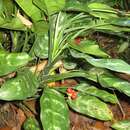Comprehensive Description
provided by Smithsonian Contributions to Botany
Aglaonema section Aglaonema
Roots rarely approaching the stem in thickness. Stem erect to partially decumbent, 10–200 cm tall, 0.2–6.0 cm thick. Internodes 0.4–3.0 (5) cm long. Petiolar sheaths conspicuous, (0.8) 4–17 (25) cm long, (0.1) 0.3–0.8 (1) times as long as the petiole. Leaf-blades ovate-elliptic to lanceolate-narrowly elliptic, occasionally broadly ovate to sublinear; variegation rarely affecting the lower leaf surface, never with a central white stripe; venation undifferentiated to weakly or strongly differentiated. Cataphylls usually found only among the inflorescences (except possibly in A. rotundum and A. pumilum). Peduncles solitary to 7 together. Spathe (1) 3–7 (12) cm long. Spadix thin-cylindric to clavate, (1.2) 2.5–5.0 (7) cm long, from l/2 the spathe length to exceeding the spathe by 1 cm; pistillate portion 0.2–1.0 (2) cm long, pistils (3) 10–25 (38); staminate portion rarely (A. tenuipes) with a gap between staminate and pistillate portions. Fruits ellipsoidal, green but turning yellow and finally red, up to 3 cm long and up to 1.5 cm thick.
- bibliographic citation
- Nicolson, Dan H. 1969. "A revision of the Genus Aglaonema (Araceae)." Smithsonian Contributions to Botany. 1-69. https://doi.org/10.5479/si.0081024X.1
Comprehensive Description
provided by Smithsonian Contributions to Botany
Aglaonema section Chamaecaulon Nicolson
Caudex repens, internodiis vix 0.5 cm longis; cataphylla petiolum plerumque amplexa, nonnumquam, deliquescens; petioli vagina usque ad 1 cm longa, vix ⅕ petioli longitudinis.
Roots frequently approaching the stem thickness. Stem repent and often branching, usually less than 1 cm thick. Internodes usually less than 0.5 cm long. Petiolar sheaths inconspicuous, to 1 cm long, 0.03–0.15 times as long as the petiole. Leaf-blades lanceolate to ovate, rarely narrowly elliptic; variegation none or with white spots affecting both sides of leaf and/or a central white stripe on or over the midrib; venation usually differentiated. A cataphyll subtending and clasping each petiole, this soon deliquescent in A. costatum. Peduncle solitary. Spathe (1.5) 2.5–4.0 (5) cm long. Spadix ellipsoidal-cylindric, (1.2) 1.8–3.5 cm long, commonly exceeding spathe by 0.3–1.0 (1.5) cm; pistillate portion 0.2–0.5 cm long, pistils 6–13. Fruits red, 1.2–1.7 cm long, 0.5–1.0 cm thick.
TYPE OF SECTION.—Aglaonema costatum N. E. Brown.
DISTRIBUTION.—Two species of continental Southeast Asia.
HABITAT.—Humid shady places below 500 m.
The section Chamaecaulon is characterized by a creeping and branching habit, exceedingly short petiolar sheaths, and the occurrence of cataphylls among the leaves. In these characters it is similar to two genera that are considered to be closely related, Aglaodorum (west Malesia) and Anubias (Africa); however, unlike Aglaonema, both these genera are tidal mudflat or swamp dwellers.
Within the genus Aglaonema, several of the smaller species, such as A. pumilum and A. rotundum, seem to be intermediate between the two sections. These rare and poorly known species are decumbent, occasionally have short petiolar sheaths, and may have cataphylls among the leaves.
- bibliographic citation
- Nicolson, Dan H. 1969. "A revision of the Genus Aglaonema (Araceae)." Smithsonian Contributions to Botany. 1-69. https://doi.org/10.5479/si.0081024X.1

